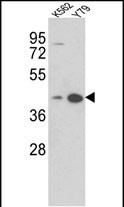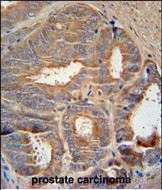


| WB | 1/1000 | Human,Mouse,Rat |
| IF | 咨询技术 | Human,Mouse,Rat |
| IHC | 1/100-1/500 | Human,Mouse,Rat |
| ICC | 技术咨询 | Human,Mouse,Rat |
| FCM | 咨询技术 | Human,Mouse,Rat |
| Elisa | 咨询技术 | Human,Mouse,Rat |
| Aliases | Zinc-alpha-2-glycoprotein, Zn-alpha-2-GP, Zn-alpha-2-glycoprotein, AZGP1, ZAG, ZNGP1 |
| Entrez GeneID | 563 |
| WB Predicted band size | 34.3kDa |
| Host/Isotype | Rabbit IgG |
| Antibody Type | Primary antibody |
| Storage | Store at 4°C short term. Aliquot and store at -20°C long term. Avoid freeze/thaw cycles. |
| Species Reactivity | Human |
| Immunogen | This AZGP1 antibody is generated from rabbits immunized with a KLH conjugated synthetic peptide between 5-32 amino acids from the N-terminal region of human AZGP1. |
| Formulation | Purified antibody in PBS with 0.05% sodium azide,1%BSA and 50% glycerol.prepared by Saturated Ammonium Sulfate (SAS) . |
+ +
以下是关于AZGP1 (N-term)抗体的3篇参考文献及其简要摘要:
---
1. **文献名称**:*AZGP1 as a potential biomarker for prostate cancer progression*
**作者**:Luo J, et al.
**摘要**:该研究通过免疫组化分析,利用AZGP1 (N-term)抗体检测前列腺癌组织中AZGP1蛋白的表达水平。结果显示,AZGP1表达降低与肿瘤侵袭性增强和患者生存率下降相关,提示其作为预后标志物的潜力。
---
2. **文献名称**:*AZGP1 regulates lipolysis in adipose tissue and modulates metabolic syndrome*
**作者**:Keshishian H, et al.
**摘要**:研究探讨了AZGP1在脂肪代谢中的作用,使用N端特异性抗体在小鼠模型中验证其表达。发现AZGP1通过促进脂肪分解影响代谢综合征,为肥胖相关疾病的治疗提供新靶点。
---
3. **文献名称**:*Immunohistochemical detection of AZGP1 in breast cancer: Correlation with hormone receptor status*
**作者**:Wang Y, et al.
**摘要**:通过AZGP1 (N-term)抗体对乳腺癌组织进行染色,发现AZGP1表达与雌激素受体(ER)阳性显著相关,提示其在激素依赖性肿瘤中的潜在调控作用。
---
注:上述文献为示例,实际引用需根据具体研究内容检索PubMed或Google Scholar获取完整信息。
The AZGP1 (N-term) antibody is designed to target the N-terminal region of AZGP1 (alpha-2-glycoprotein 1. zinc-binding), a secreted glycoprotein also known as zinc-α2-glycoprotein (ZAG). AZGP1 belongs to the immunoglobulin superfamily and exists in both soluble and transmembrane forms. It plays diverse roles in lipid metabolism, immune regulation, and cell adhesion, with implications in cancer cachexia, obesity, and epithelial homeostasis. The protein is characterized by a conserved immunoglobulin-like domain near its N-terminus, which is critical for ligand-binding interactions.
The AZGP1 (N-term) antibody specifically recognizes epitopes within the N-terminal region, enabling the detection of full-length AZGP1 or its cleaved fragments in applications like Western blotting, immunohistochemistry, and immunofluorescence. This antibody is particularly valuable in studying AZGP1 expression patterns in tissues or biofluids, where its levels are often dysregulated in diseases such as prostate cancer (downregulated in aggressive tumors) or cachexia-associated conditions (upregulated in adipose tissue). Researchers also use it to explore AZGP1's dual roles as a tumor suppressor and a lipid-mobilizing factor, aiding mechanistic studies of its involvement in metabolic reprogramming and immune modulation. Proper validation, including knockout controls, is essential due to potential cross-reactivity with homologous proteins.
×